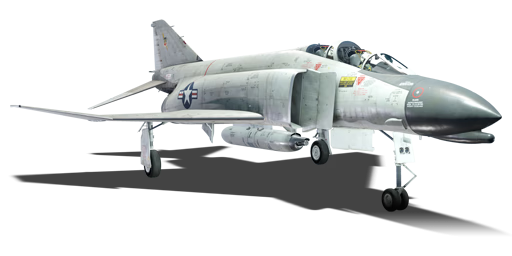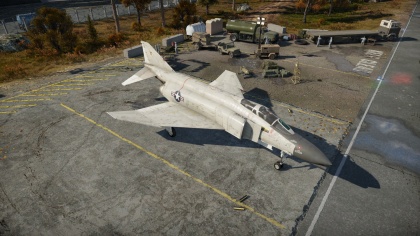F-4C Phantom II
Contents
Description
The F-4C Phantom II is a rank VII American jet fighter with a battle rating of 10.7 (AB/SB) and 10.3 (RB). It was introduced in Update 1.91 "Night Vision".
General info
Flight performance
Describe how the aircraft behaves in the air. Speed, manoeuvrability, acceleration and allowable loads - these are the most important characteristics of the vehicle.
Survivability and armour
Examine the survivability of the aircraft. Note how vulnerable the structure is and how secure the pilot is, whether the fuel tanks are armoured, etc. Describe the armour, if there is any, and also mention the vulnerability of other critical aircraft systems.
Armaments
Suspended armament
The F-4C Phantom II can be outfitted with the following ordnance:
- 1 x 20 mm M61 Vulcan rotary cannon in a SUU-16/SUU-23 gun pod (approximately 1200 rounds)
- 2 x additional SUU-16/SUU-23 gun pods for a total of 3 x M61 Vulcan 20 mm cannons
- 18 x 250 lb. Mk.81 bombs
- 18 x 500 lb. Mk.82 bombs
- 12 x 750 lb. M117 cone 45 bombs
- 8 x 1000 lb. Mk.83 bombs
- 2 - 4 x AGM-12 Bullpup Air-to-Surface Missiles
- 48 x Mk. 32 Zuni ATAP rockets
- 228 x FFAR "Mighty Mouse" rockets
- 4 x AIM-9B Sidewinder missiles
Usage in battles
Describe the tactics of playing in an aircraft, the features of using vehicles in a team and advice on tactics. Refrain from creating a "guide" - do not impose a single point of view, but instead, give the reader food for thought. Examine the most dangerous enemies and give recommendations on fighting them. If necessary, note the specifics of the game in different modes (AB, RB, SB).
Pros and cons
Summarise and briefly evaluate the vehicle in terms of its characteristics and combat effectiveness. Mark its pros and cons in the bulleted list. Try not to use more than 6 points for each of the characteristics. Avoid using categorical definitions such as "bad", "good" and the like - use substitutions with softer forms such as "inadequate" and "effective".
Pros:
- Good manoeuvrability for a jet of its size
- Centerline gun pod is default weapon
- Wide variety of payload options
- One of the fastest aircraft in the game
- Has access to AIM-9 Sidewinders
- Excellent rate of climb
- Good roll rate
- M61 Vulcan is devastating to enemy aircraft
Cons:
- Missiles are a Tier IV modification
- Large target profile for a fighter
History
In the early 1950s, McDonnell Aircraft began work on a revised design of their F3H Demon naval fighter, in an effort to expand upon its capabilities and improve performance in general. By September 1953, the design was submitted for Navy consideration. Showing interest in the project, the U.S. Navy ordered the construction of a mock-up and expressed interest in potentially procuring the type.
By 1955, however, the U.S. Navy changed the requirements for the aircraft substantially. Instead of a multipurpose aircraft, the new design was now supposed to act as a two-seat, long-range, all-weather fleet interceptor. Having revised the design, orders were issued for the construction of two XF4H-1 prototypes as well as an additional five pre-production F4H-1s. Following comparative testing against other machines in service with the Navy at the time, the F4H proved itself as highly capable aircraft and was thus ordered into full-scale production as the F-4. The name ‘Phantom II’ was given to the aircraft at McDonnell’s 20th anniversary celebration in July 1959.
Some time after the Navy procured the F-4, other branches of the U.S. military also became interested in the aircraft. A result, the USAF also introduced a special “army” version of the F-4 into service during the mid 1960s under the designation F-4C.
The F-4 Phantom II would become one of the most produced and widely used American combat aircraft of the second half of the 20th century. With over 5,100 machines being built, the F-4 Phantom II saw service with several operators around the globe and remained in service until the 1990s, while some still serve to this day. Phantom II is widely known as a symbol of the US campaign in Vietnam, in particular.
- From Devblog
Media
Excellent additions to the article would be video guides, screenshots from the game, and photos.
See also
Links to the articles on the War Thunder Wiki that you think will be useful for the reader, for example:
- reference to the series of the aircraft;
- links to approximate analogues of other nations and research trees.
External links
| USA jet aircraft | |
|---|---|
| Fighters | |
| F9F | F9F-2 · F9F-5 · F9F-8 |
| F-80 | F-80A-5 · F-80C-10 |
| F-84 | F-84B-26 · F-84F · F-84G-21-RE |
| F-86 | F-86A-5 · F-86F-25 · F-86F-2 · F-86F-35 |
| F-89 | F-89B · F-89D |
| F-100 | F-100D |
| F-104 | F-104A · F-104C |
| F-4 | F-4C Phantom II · F-4E Phantom II · F-4J Phantom II · F-4S Phantom II |
| F-5 | F-5A · F-5C · F-5E · F-20A |
| F-8 | F8U-2 · F-8E |
| F-14 | F-14A Early · ▄F-14A IRIAF · F-14B |
| F-15 | F-15A · F-15C MSIP II · F-15E |
| F-16 | F-16A · F-16A ADF · F-16C |
| Other | P-59A · F2H-2 · F3D-1 · F3H-2 · F4D-1 · F11F-1 |
| Strike Aircraft | |
| FJ-4 | FJ-4B · FJ-4B VMF-232 |
| A-4 | A-4B · A-4E Early |
| A-7 | A-7D · A-7E · A-7K |
| AV-8 | AV-8A · AV-8C · AV-8B Plus · AV-8B (NA) |
| A-10 | A-10A · A-10A Late · A-10C |
| F-111 | F-111A · F-111F |
| Other | A-6E TRAM · F-105D · F-117 |
| Bombers | |
| B-57 | B-57A · B-57B |





